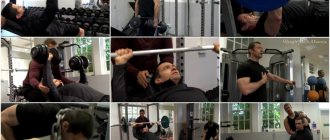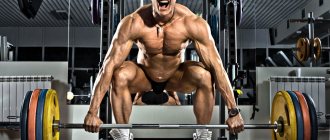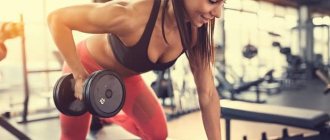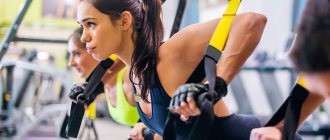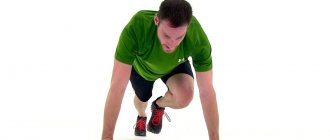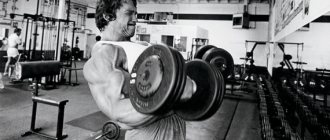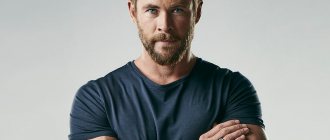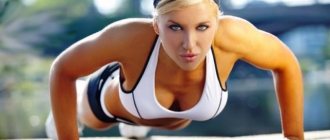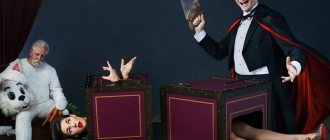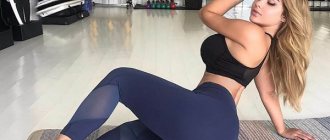Steve Reeves is an actor and bodybuilder who was known and respected by such prominent figures as Winston Churchill, Sylvester Stallone, James Dean and many others. It was about him that the eminent sculptor E. Fairbanks said that his body was a dream for Michelangelo, and if Steve had lived in the time of the master, masters would have fought for the right to create canvases and statues from his life. What causes this attitude, read on.
Biography of “the most beautiful of people”
Steven Lester Reeves was born into the light of day in a very simple family in 1926 in winter in the state. Montana in the northwest of America. As soon as the boy turned one and a half years old, his beloved dad tragically died. All the worries about her young son fell heavily on the mother’s shoulders.
Interesting! Baby Stevie became a screen star at the age of 6 months, when he was recognized as the healthiest baby in the country. For this, his mother received a cash prize.
In his childhood, he recklessly played ball with the kids in the yard, and as a teenager he began to engage in strength sports. His hobbies coincided with the dawn of the era of weightlifting, so at that time there were no sources of useful information for beginners. John Grimek became a role model for the boy. Soon the future champion shared: “My opinion about a real bodybuilder was at odds with the photos I saw on the pages of magazines. One athlete had a beautiful chest, the second had legs, the third had a back. For myself, I wanted the ideal in all respects.”
Biography pages
John Grimek was born in New Jersey back in 1910. Thanks to his older brother, the boy began to engage in strength sports early . It all started when George brought home magazines with photos of athletes and weights. After some time, he developed a new hobby, and he happily forgot about the shells. And John really wanted to grow big and strong, and he began to train on his own. In his youth, John Grimek already had a beautiful figure with a contoured relief, which he was very proud of. At the age of 18, the guy combined the professions of a loader and a model. Hard work contributed to gaining mass, and working with artists taught posing and the ability to present oneself.
Steve Reeves' debut experience
- Having studied the material available in the press, the boy independently developed a training program for himself and even began training with a barbell.
- This is how he gained initial experience and moved to a sports club. Surprisingly, the owner of the hall, Edd Yarik, began to deal with Steve. The man immediately realized how great the boy’s potential was and began to work hard “with promising raw materials.”
- Reeves managed to gain 16.5 kilograms in just 4 months. After the first successes, a mass plateau arrived.
- Another 4 weeks ended, but no changes were observed, only the muscles became much larger and more prominent. Over time, the athlete gained another 5 kilograms.
- After 3 months, it was impossible not to notice his pumped up and tall figure. Colleagues in the gym were shocked by such dramatic changes in the body of the young athlete.
First experience
Based on materials in the press, the teenager drew up a training plan for himself and began training in the garage with a barbell. After gaining a little experience, Steve signed up for the gym and unexpectedly fell under the tutelage of Edd Yarik, the owner of the club. He immediately recognized the guy’s potential and decided to work with the “raw material.” In 4 months at the age of 16.5, the young man gained 14 kilos of muscle. Then came the sports plateau.
4 weeks passed, but there was no change in the mass, only the muscles became more prominent and denser. The next month the weight progression was 5 kg. And just a block away, it was impossible not to notice a tall, muscular figure. The jocks with 4 years of experience were shocked by this transformation.
However, the guy did not train for volume. “When I came to the gym, the girth of my biceps did not exceed 34 cm, my ankles – 41 cm. In order not to increase the disproportion, I stopped pumping my calves and waited for the arm muscles to become equal to the parameters of my shins. Then I pumped up my neck and calves to 44 cm and calmed down.”
Steve's anthropometry data
Larry Scott Steve, the first Mr. America, called Steve Reeves "the most beautiful of people." This title is especially valuable, since the athlete achieved ideal forms without the use of steroids.
The experience of natural bodybuilding became motivation for beginners, and sparked tens of thousands of acting careers, such as Arnold Schwarzenegger and Phil Heath.
Steve Reeves: I don’t understand why you should ruin your body with steroids. If an athlete lacks natural testosterone, then it is better to play ping pong.
Photos by Steve Reeves show the following data:
- height - 1 m 85 cm;
- training weight - 98 kg;
- biceps volume - 47 cm;
- waist circumference - about 73 cm;
- torso circumference - 1 m 28 cm;
- neck circumference - 46 cm.
At the time of Reeves, only a few were engaged in bodybuilding, so the figure of Hercules constantly attracted the attention of others. At just under 30 years old, the guy became the star of the Muscle Coast beach, and there a retinue of fans followed him on his heels.
Anthropometric data
Steve Reeves height and weight:
- at 185 cm, body weight did not exceed 98 kg;
- biceps girth - 47 cm;
- waist - almost 73 cm;
- torso - 128 cm;
- neck 46.35 cm.
At a time when only a few people were involved in bodybuilding, a pumped-up figure attracted everyone's attention. For 30 years, the athlete was a star on the Muscle Coast beach and was followed by a crowd of fans.
Reeves' military-sports youth
- Immediately in 1944, after completing his studies at school, the young man was called up for army service. After six months of training, he was already sitting in the Philippine trenches, after which he participated in the Battle of Ballet Pass.
- The young man contracted malaria and went to a military hospital, where he lost 15 kg of body weight. Upon recovery, the athlete was transferred to Otaraon, and then to Tokyo. Already there the guy purchased a barbell weighing 100 kg, which he hid under the bed, and worked hard to return to his former shape.
- After 2 years of service, Stephen returned home, and 3 months later he had already chosen the Mr. Pacific Coast award in 1946.
- In 1947, the athlete became the best at the “Mr. West Olympia" for the best shape of quadriceps, biceps, and torso.
- At just 21 years old, the guy received the title “Mr. America" (1947), where he rode 35 competitors, including the super-star of the world of bodybuilding George Eiferman.
Military youth
In 1944, after graduating from school, the young man was immediately drafted into the army . After 6 months of training, he was already in a trench in the Philippines, then fought at Ballet Pass.
“If I hadn’t perceived myself as a spectator watching the story from the audience, I don’t know what would have happened to my psyche when I saw my wounded comrades.”
Then Reeves was hospitalized and lost 15 kg of weight. After treatment, the company was transferred to the Japanese city of Otaraon, then to Tokyo. In the capital, a soldier ordered a 100 kg barbell, which he then kept under his bed. A little time passed, and the guy made up for the lost kilograms.
Acting career as a bodybuilder
With the growth of a bodybuilder's career, the demand for this type of figure in theatrical circles has increased. Steve realized that he wouldn’t last long on the income from bodybuilding, so he decided to accept an offer from agents to act in films.
Reeves' most famous films:
- "The Labors of Hercules";
- "The Last Day of Pompeii";
- "Trojan War"
- "Il figlio di Spartacus";
- "Romulus and Remus" and others.
At a certain period of his life, Stephen showed himself as an author. His book “Building a Classic Physique. The Natural Way" is completely autobiographical, and describes in detail all the ups and downs of Steve's life, his comments and statements about himself.
"An Athlete from Another Galaxy"
These are the words of a photographer who photographed bodybuilders. Amazed by the athlete's proportions, he said that his idea of beauty had changed. Euphoria about the external perfection of a bodybuilder began in theater circles. An agent from one of the studios suggested that the star learn the acting skills using a new method.
“It is impossible to live on income from sports. This was the reason for filming the movie.”
However, the first experience of actor Steve Reeves was unsuccessful . Steve was annoyed by the imposed role, and he moved to Theodore Irving School. Together with comedian Dick Burney, he performed at small venues in large cities. Soon he met the Hollywood movie monster, Cecila DeMile, and began filming Samson and Delilah, losing 5 kg at the director’s request. The athlete experienced discomfort and refused the role . He returned to the gym and gained weight again. Ahead lay the prospect of winning Mr. Universe and facing off against John Grimek.
leading roles in films were ahead. In his filmography:
- In 1957, he starred in The Labors of Hercules;
- then in The Last Day of Pompeii;
- "Trojan War";
- "Son of Spartacus";
- "Romkl and Rem" and others.
A total of 17 works .
Mr. Reeves's sports career
- The title “Mr. Universe” never went to the natural bodybuilder, but the King of Denmark invited Reeves to become his personal trainer, and he refused such a tempting offer.
- In 1948, the French Cannes “Mr. World” award fell under the bodybuilder’s feet, the jury of which was amazed by the natural parameters of the athlete.
- In 1950, after intense training and persistent struggle, the athlete became the champion at the Mr. Universe competition.
Mister Universe tricks
- In 1936, the bodybuilder participated in the Olympic Games , but was left without a prize.
- Then he decided to move to the middle weight category and in 1940 he performed at Madison Square Garden. He bench pressed 130 kg, but failed to rise above 3rd place. A little later he became “the most muscular athlete.” From that moment another life began.
- In 1940, John performed for the first time in competitive bodybuilding and captivated the audience with his forms, grace, and plasticity. The athlete did not pose easily, but also demonstrated dexterity when performing gymnastic tricks. The 30-year-old athlete had no competitors at this competition.
- In 1941, John again won Mr. America, but temporarily stopped competing due to bans from the AAU federation.
- In 1948 he returned to competitive bodybuilding and at the age of 38 received the title “Mr. Universe”.
The judges were surprised by a trick involving a weightlifting belt. Grimek pulled it so tightly around his waist that a bowler hat slipped between his stomach and the belt. The athlete has always been stubborn and hardworking. Even in adulthood, I could squat 190 kg without difficulty. The bodybuilder died at the age of 88.
Champion Training Basics
All Steve Reeves training is subject to certain principles and rules. In the 90s, the owner of the house that the athlete was renting found a diary in which the training program was recorded with notes and explanations. Here are the main ones:
- Prefer basic exercises.
- Do 12 repetitions per set, and 20 repetitions for the legs, and leave them until the end of the training.
- The work must be technical, and the muscles must be loaded to capacity. If you fail, increase the weight and reduce the repetitions to 7, and then increase again to 12 times.
- Change the weight every 15 workouts.
- Use a variety of grips. This way you will pump up your muscles “from different sides”.
- Walk more on rough terrain with a weight of 2 kg hanging on your arms, 1 kg on your legs, and 8 kg on your belt.
- Cardio is the optimal choice for the drying process.
- Drink plenty of fluids during training. For energy, add lemon juice and honey.
Few athletes in the history of bodybuilding have built as impressive a back taper as Steve Reeves. His 125 cm chest was crowned by a magnificent 72 cm waist. The director saved one of the most striking episodes of the famous film “Hercules” for the finale - grabbing the chains, Reeves’ hero brings down the pillars supporting the powerful vaults of the temple. It is at this moment that viewers see the amazing range of the latissimus dorsi muscles of one of the greatest bodybuilders of all time.
Reeves' figure has been the admiration of thousands of bodybuilders and athletes for more than 50 years. Ellington Darden, Roger Schwab, Larry Scott, Arnold Schwarzenegger, Bill Pearl and Lou Ferrigno are just a few of the athletes who have spoken highly of Reeves. He was the true embodiment of bodybuilding. Most bodybuilders have always wondered how Reeves managed to build such a back, how he made his muscles so thick and impressively converging to the waist, what exercises did he use to create his legendary figure? Fortunately for us, after winning the 1947 Mr. America competition, Reeves wrote a series of articles about his training principles and programs. We present excerpts from them below: Latissimus The most important group of back muscles is the latissimus. They start at the armpits and go down to the waist. It is the lats that give the back that same look, visually widening the shoulders. Therefore, any serious athlete tries with all his might to develop them. This is a real salvation for those whom nature has not blessed with broad shoulders. “I will list just a few of the exercises that allowed me to receive the “Best Back” prize at the Mr. America 47 tournament. • Bent Over Rows: A great exercise for building your lats. It is best performed with your head resting on a soft support to prevent cheating. From my own experience, I can conclude: if you pull the barbell higher towards the chest, then the upper regions of the lats develop more; if towards the stomach, then the lower regions, close to the waist. • Bent-over one-arm dumbbell rows: This is the best exercise for building your lats. When performed correctly, it gives them maximum load throughout the entire amplitude - full stretch and hard contraction. This exercise is performed in the same way as the previous one, with one exception - instead of supporting your head, you lean on the bench with your free hand and the corresponding knee. Another useful tip: start the exercise with your weak hand. This way you will do the required number of repetitions for it, and then do the same for your stronger arm. This way you will ensure balanced development. Thanks to the technique described above, I achieved equal development of strength in both hands. • High pull-downs: This is my favorite exercise. Along with incline benches, high pulleys were a fixture in all West Coast gyms. I attribute a good portion of my back development to working on a high block. Using a high block, I widened my back without resorting to pull-ups, which are not very suitable for me. The block is also good because it allows you to shift the angle of thrust in any direction, further expanding your shoulders. • Pullovers: This is a very good exercise for both form and definition, especially when using dumbbells. Here you have more freedom in movement, and your muscles receive a fuller load. In addition, a high bench should be used in this exercise, then the range of movement will be maximum. Starting with the deltoids “Working on the upper body, from my own feelings and from observing the training of other athletes, I came to the conclusion that training should begin with working on the deltoids. For most people, the deltoids are the hardest muscles to develop. Of course, you've seen plenty of bodybuilders with superbly developed front and middle deltoids. However, an athlete with fully developed all three fascicles (including the rear) of the deltas is a rarity. Large, wide deltoids are an assessment of an excellent physique. They exude power and confidence. If you have developed your shoulders and lower legs to the maximum, I guarantee that you are capable of having a mind-blowing physique! I highly recommend that you start your workout by working your delts when your energy levels, concentration, and enthusiasm are at their highest.”
We need to create an ideal line of communication between the brain and muscles. This can be done in two ways: concentration and practicing muscle control during non-training times. When you can get your muscles to contract in response to your brain's commands, then the connection between your brain and your muscle fibers is excellent. By creating the perfect line of communication, I was able to build muscle faster and easier. It saved me time. I trained three times a week for two and a half hours, training the whole body in one session, and rested the other four days, because rest is just as important as training.
So, the order in which I advise you to train the muscles of your body: 1. Deltas. 2. Chest. 3. Lat. 4. Biceps. 5. Triceps. 6. Quadriceps. 7. Biceps femoris. 8. Calf. 9. Lower back. 10. Press. 11. Neck.” Maximum Muscle Development For maximum muscle development, you should use a weight that you can do 8 to 12 reps per set with perfect form and resting 45 seconds between sets. I call the ideal technique for performing an exercise when each repetition is done slowly and smoothly, without jerking or swaying. Each repetition should be performed through the full range of motion for each muscle. Raising the weight should be done within 2 seconds and lowering within 3 seconds. Most people neglect the negative phase of the movement, but you must be extremely focused on the muscle being worked equally during both the lifting and lowering phases.
Life after career
- Having earned worldwide recognition, Reeves left sports and cinema and moved to California to organize his own business.
- His personal life is rich with three marriages. From 1994 until his death in 2000, he was married to Deborah Ann Angelhorn. The athlete had two children with this Polish noblewoman.
- The bodybuilder bought a ranch, began breeding horses, and continued to promote healthy eating and exercise in the media.
- In 2000, at the age of 74, Steve died of lymphoma.
- The famous athlete remained for hundreds of thousands of fans an unsurpassed natural bodybuilder with the body of Hercules, a talented, spiritual and comprehensively developed person.
What is your opinion about the iconic Steve Reeves? Share your thoughts with readers in the comments below.
Childhood memories
Steven Lester Reeves was born into an ordinary family in the winter of 1926 in the northwestern United States in Montana. When the baby was 18 months old, his father tragically died. Caring for the only child fell entirely on the mother.
Steve became a star at the age of 6 months, when he was recognized as the healthiest baby in the country and was given a bonus to his mother.
As a child, he kicked a ball with the neighborhood boys, but as a teenager he became interested in strength sports . In the 40s, the era of iron sports was just beginning, and there was almost no information on this topic. After reading several sports magazines and assessing the muscles of John Grimek and his rivals, the boy decided to lift weights. The athlete later admitted:
“None of the pictures shocked me so much that I wanted to look up to someone. One athlete had excellent legs, the second had a well-developed chest. In my mind, a bodybuilder’s figure should be ideal, so in my imagination I assembled an idol from various puzzles.”
Information about Steve Cook from his website, as well as from an interview with CutAndJacked.com:
Steve Cook's competition history:
- 2010 Bodybuilding.com Fit Body – 1st place
- 2011 NPC Ironman Magazine Championship – 1st place
- 2011 US Junior Championships NPC – 3rd place
- 2011 National Junior Championship NPC – 1st place
- 2012 IFBB Houston Pro – 1st place
- 2013 IFBB Olympia Men's Physique – 8th place
- 2014 IFBB Dallas Pro – 1st place
- 2014 IFBB Olympia Men's Physique – 5th place
Steve Cook is one of the people who have most often personified the fitness industry in recent years. Steve is mainly known as a professional competitor in the Men's Physique category (beach bodybuilding), the face of Optimum Nutrition and Bodybuilding com, and an international fitness model. Steve Cook regularly helps people, informing and guiding millions through his projects on Bodybuilding com, in association with Optimum Nutrition, and through social media. Before he began performing on shows and modeling, Steve was already an accomplished college athlete, playing college football, and earning a Bachelor of Science degree from Dixie College in biology and psychology.
"More. Faster. Stronger". That was the family motto when Steve Cook was growing up. This was the motto he heard every day. Steve was the son of a coach and sports manager, the middle child in a family of 7 children, all of whom played sports. Like many middle children, Steve Cook did his best not to get lost in the chaos of a large family. Under his father's supervision, he began to excel not only in the stadium, but also in the gym at a very early age. Push-ups were mandatory for him before he was allowed to watch TV or hang out with friends. Steve also fanatically did push-ups before going to bed. Doing push-ups every day built his brain-muscle connection. This neuromuscular connection was the key to Steve Cook's success in sports and bodybuilding in the future.
Steve got his first set of weights when he started high school. By the sixth grade, he could already bench press 92kg. He continued to lift weights, not because it gave him an advantage in other sports, but because he enjoyed the process. In the 9th grade, Cook bench pressed 144 kg and was one of the strongest kids among his peers.
During his time in college, Steve Cook became stronger and bigger. Unlike other American football players, who only did sport-specific exercises, Steve was also interested in building muscles. Arnold Schwarzenegger's Encyclopedia of Bodybuilding helped Cook learn how to build muscles and gain mass. When his football career came to an end, Steve decided to continue training as a pure bodybuilder. In 2009, Steve Cook was already involved in the bodybuilding industry.
At his first competition on 11/21/2009 in Las Vegas, Cook won and made a name for himself in bodybuilding at the national level. This was an incredible achievement for an amateur bodybuilder. At the same time, things weren’t going well in Cook’s personal life. In early 2010, after four years of marriage, Steve Cook and his wife decided to divorce. At that moment, this became a blow for Cook, from which he recovered, directing all his strength to where he would never be let down - into the hall.
In April 2010, Steve Cook took first place at the ABFF Show/Boise Golds Gym Classic and received his pro card.
i-pump with Steve Cook in Madrid, September 2014:
When asked which bodybuilder he likes best, Steve Cook replied:
“I really like aesthetic figures. Of course, my favorite athlete is Arnold, I met him when I was 7 years old and have been his fan ever since. I also like Steve Reeves, Frank Zane, Bob Paris, Serge Nubret, Lee Labrada."
Steve Cook on how much time he spends in the gym:
“From 1 to 1.5 hours. I like to change up my workout routine every 2 weeks. When I'm working on strength, I often only train for 45 minutes."
Steve Cook on his pre-competition diet:
“My diet doesn’t change much throughout the year. I usually don’t move more than 2.5 kg from my competition weight in the off-season. In the off-season, I allow myself more carbohydrates and enjoy fruits and milk. Closer to competitions or photo shoots, I start cutting down on carbohydrates (I cycle them). I eat 250 to 300 grams of protein per day, and 50 to 70 grams of fat. I eat on average 6 times a day. The basis of the diet is low-fat sources of protein such as turkey, chicken and fish.”
Steve Cook Diet (off-season):
First meal:
- 8 egg whites
- 2 whole eggs
- Vegetables (spinach, bell pepper) – 1 serving
- Oatmeal – 60-80g
Second meal:
- Low fat source of protein (white fish, chicken, turkey, steak) – 200g
- Source of complex carbohydrates (brown rice or sweet potatoes) – 70g
Third meal (after training):
- Protein powder – 40g
- Maltodextrin – 50-100g
Fourth meal (about an hour after the previous one):
- Lean meat – 200g
- Source of complex carbohydrates (whole wheat pasta, brown rice or sweet potatoes) – 70-90g
- Vegetables – 1 serving
Fifth step write:
- Lean meat – 200g
- Vegetables – 1 serving
- Sources of healthy fats (almonds or almond butter, avocado or olive oil) – 10-20 g
Sixth meal:
- Repeat the fifth meal or protein bar
Seventh meal (before bed):
- Casein protein – 1.5 scoops
- Sources of healthy fats (almonds or almond butter, avocado or olive oil) – 10-20 g
Supplements Steve Cook Recommends:
- Multivitamins Opti-Men
- BCAA 1000 Caps ON
- Glutamine ON
- HMB
- Creatine ON
- Fish oil ON
- 100% Gold Standard Whey ON
- 100% Gold Standard Casein ON
- Platinum Hydro Whey ON
- Beta Alanine
- Amino Energy ON
- Green tea extract
- ZMA ON
Steve Cook on the temptation to eat junk food:
“I do this so that I don’t feel hungry. To do this, I need it every 2-3 hours, and if I still want to eat between meals, then I find some healthy alternative for a snack, like almond butter.”
Steve Cook's training program (off-season):
Day 1 (hips, lower legs):
- Leg extension on the machine: 2*15 (warm-up), 1*10-12 to failure
- Leg press: 2*10-12 (warm-up), 1*10-12 to failure
- Hack squats: 2*10-12 (warm-up), 1*10-12 to failure
- Leg bending on a sitting machine: 1*10-12 (warm-up), 1*10-12 to failure
- Deadlift with straight legs: 1*10-12 (warm-up), 1*10-12 to failure
- Shin in the leg press machine: 1*10-12 (warm-up), 3 sets in rest-pause mode, rest between sets 10-15 seconds
- Lower leg in a sitting machine: 1*10-12 (warm-up), 1*6-8 to failure
Day 2 (chest, biceps, abs):
- Incline bench press with head down: 2*10-12 (warm-up), 1*6-8 to failure
- Dumbbell bench press on an inclined bench with your head up: 1*10-12 (warm-up), 1*6-8 to failure
- Lying dumbbell fly: 1*10-12, 1*6-8 to failure
- Concentrated dumbbell lift for biceps: 1*10-12 (warm-up), 1*6-8 to failure
- Hummer: 2*6-8 to failure
- Barbell curl: 2*8-10 using cheating and negative reps
- Superset Knee Raises with Crunches: 3 sets to failure, slow controlled movements
- Crunches using a superset block with leg raises lying on an incline bench: 3 sets to failure
Day 3:
- Cardio
Day 4 (back, triceps, calves):
- Pullover with dumbbell: 2*10-12 (warm-up), 1*8-10 to failure
- Close-grip vertical block row: 1*10-12 (warm-up), 1*8-10 to failure
- Bent-over dumbbell row: 1*10-12 (warm-up), 1*8-10 to failure
- Wide grip horizontal block row: 1*10-12 (warm-up), 1*8-10 to failure
- Deadlift: 1*10-12 (warm-up), 1*8-10 to failure
- Triceps on the block: 1*10-12 (warm-up), 1*8-10 to failure
- French bench press: 1*10-12 (warm-up), 1*8-10 to failure
- Seated French press: 1*10-12 (warm-up), 1*8-10 to failure
- Shin in the leg press machine: 1*10-12 (warm-up), 3 sets in rest-pause mode, rest between sets 10-15 seconds
- Lower leg in a sitting machine: 1*10-12 (warm-up), 1*6-8 to failure
Day 5 (delts, trapezius, abs):
- Seated dumbbell press: 1*10-12 (warm-up), 1*8-10 (warm-up), 1*6-8 to failure
- Dumbbell swings to the sides: 1*10-12 (warm-up), 1*8-10 to failure
- Rows on a horizontal block with a rope handle to the chin: 1*6-8 to failure
- Swing dumbbells to the sides while lying on your stomach on an incline bench: 1*10-12 (warm-up), 1*8-10 to failure
- Shrugs with dumbbells or barbell: 1*12-15 (warm-up), 2*8-10 to failure
- Close-grip row to the chin while standing: 1*12 (warm-up), 2*8-10 to failure
- Superset Knee Raises with Crunches: 3 sets to failure, slow controlled movements
- Crunches using a superset block with leg raises lying on an incline bench: 3 sets to failure
Day 6:
- Cardio
The next day this 6-day cycle repeats again.
Rest 1 minute between sets unless otherwise directed.
Original source 1
Source 2
Translation and note-taking:
- Read the article “Greg Plitt’s 12 Laws”
- Read an interview with Simeon Panda
Liked? Share with your friends!
Higher, further, stronger
The star spent her childhood and youth under this motto. Steve Cook was born on December 10, 1984 in Idaho, Boise, in the family of a coach and sports manager. Besides him, his parents raised 6 more children. Everyone was involved in athletics and fitness. Steve showed good results in running and gym. Push-ups were a mandatory requirement of the daily program. Only after a certain number of repetitions did his father allow him to go outside or watch TV.
“I liked the feeling in the muscles. The blood circulated through my veins as if it were being pumped. So I treated fitness like a game.”
Every week his muscles became more and more powerful, and the contours of his figure became clearer. In high school, the teenager combined strength training with American football.
In the 9th grade, Steve Cook already bench pressed 145 kg, and was the strongest in school.
Masterly possession of the ball allowed the young man to receive a scholarship for 4 years and pay for college.
Unlike his comrades, Steve worked out according to the program compiled by his father, trying to develop all muscle groups proportionally. By the end of his training, the guy knew what he would do next, and completely switched to bodybuilding. All that remained was to figure out diet and supplements. Even then, Cook decided once and for all for himself that he would not use steroids.
“I want to have a body with ideal proportions that crowds of people will want to look at.”
So said Steve after reading Schwarzenegger's motivating Encyclopedia of Bodybuilding. This book played a big role in the athlete’s life. Inspired by the successes of Iron Arnie, Serge Nubret, and Steve Reeves, the guy decided to become like them and focused on training.
